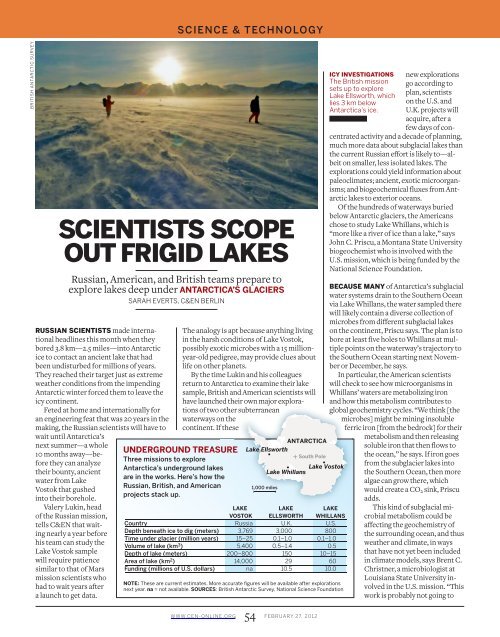February 27, 2012 - IMM@BUCT
February 27, 2012 - IMM@BUCT
February 27, 2012 - IMM@BUCT
Create successful ePaper yourself
Turn your PDF publications into a flip-book with our unique Google optimized e-Paper software.
BRITISH ANTARCTIC SURVEY<br />
SCIENCE & TECHNOLOGY<br />
SCIENTISTS SCOPE<br />
OUT FRIGID LAKES<br />
Russian, American, and British teams prepare to<br />
explore lakes deep under ANTARCTICA’S GLACIERS<br />
SARAH EVERTS , C&EN BERLIN<br />
RUSSIAN SCIENTISTS made international<br />
headlines this month when they<br />
bored 3.8 km—2.5 miles—into Antarctic<br />
ice to contact an ancient lake that had<br />
been undisturbed for millions of years.<br />
They reached their target just as extreme<br />
weather conditions from the impending<br />
Antarctic winter forced them to leave the<br />
icy continent.<br />
Feted at home and internationally for<br />
an engineering feat that was 20 years in the<br />
making, the Russian scientists will have to<br />
wait until Antarctica’s<br />
next summer—a whole<br />
10 months away—before<br />
they can analyze<br />
their bounty, ancient<br />
water from Lake<br />
Vostok that gushed<br />
into their borehole.<br />
Valery Lukin , head<br />
of the Russian mission,<br />
tells C&EN that waiting<br />
nearly a year before<br />
his team can study the<br />
Lake Vostok sample<br />
will require patience<br />
similar to that of Mars<br />
mission scientists who<br />
had to wait years after<br />
a launch to get data.<br />
UNDERGROUND TREASURE<br />
Three missions to explore<br />
Antarctica’s underground lakes<br />
are in the works. Here’s how the<br />
Russian, British, and American<br />
projects stack up.<br />
The analogy is apt because anything living<br />
in the harsh conditions of Lake Vostok,<br />
possibly exotic microbes with a 15 millionyear-old<br />
pedigree, may provide clues about<br />
life on other planets.<br />
By the time Lukin and his colleagues<br />
return to Antarctica to examine their lake<br />
sample, British and American scientists will<br />
have launched their own major explorations<br />
of two other subterranean<br />
waterways on the<br />
continent. If these<br />
ANTARCTICA<br />
Lake Ellsworth<br />
South Pole<br />
1,000 miles<br />
+<br />
Lake Vostok<br />
Lake Whillans<br />
LAKE LAKE LAKE<br />
VOSTOK ELLSWORTH WHILLANS<br />
Country Russia U.K. U.S.<br />
Depth beneath ice to dig (meters) 3,769 3,000 800<br />
Time under glacier (million years) 15–25 0.1–1.0 0.1–1.0<br />
Volume of lake (km 3 ) 5,400 0.5–1.4 0.5<br />
Depth of lake (meters) 200–800 150 10–15<br />
Area of lake (km 2 ) 14,000 29 60<br />
Funding (millions of U.S. dollars) na 10.5 10.0<br />
NOTE: These are current estimates. More accurate figures will be available after explorations<br />
next year. na = not available. SOURCES: British Antarctic Survey, National Science Foundation<br />
WWW.CEN-ONLINE.ORG 54 FEBRUARY <strong>27</strong>, <strong>2012</strong><br />
ICY INVESTIGATIONS<br />
The British mission<br />
sets up to explore<br />
Lake Ellsworth, which<br />
lies 3 km below<br />
Antarctica’s ice.<br />
new explorations<br />
go according to<br />
plan, scientists<br />
on the U.S. and<br />
U.K. projects will<br />
acquire, after a<br />
few days of concentrated<br />
activity and a decade of planning,<br />
much more data about subglacial lakes than<br />
the current Russian effort is likely to—albeit<br />
on smaller, less isolated lakes. The<br />
explorations could yield information about<br />
paleoclimates; ancient, exotic microorganisms;<br />
and biogeochemical fluxes from Antarctic<br />
lakes to exterior oceans.<br />
Of the hundreds of waterways buried<br />
below Antarctic glaciers, the Americans<br />
chose to study Lake Whillans , which is<br />
“more like a river of ice than a lake,” says<br />
John C. Priscu , a Montana State University<br />
biogeochemist who is involved with the<br />
U.S. mission, which is being funded by the<br />
National Science Foundation.<br />
BECAUSE MANY of Antarctica’s subglacial<br />
water systems drain to the Southern Ocean<br />
via Lake Whillans, the water sampled there<br />
will likely contain a diverse collection of<br />
microbes from different subglacial lakes<br />
on the continent, Priscu says. The plan is to<br />
bore at least five holes to Whillans at multiple<br />
points on the water way’s trajectory to<br />
the Southern Ocean starting next November<br />
or December, he says.<br />
In particular, the American scientists<br />
will check to see how microorganisms in<br />
Whillans’ waters are metabolizing iron<br />
and how this metabolism contributes to<br />
global geochemistry cycles. “We think [the<br />
microbes] might be mining insoluble<br />
ferric iron [from the bedrock] for their<br />
metabolism and then releasing<br />
soluble iron that then flows to<br />
the ocean,” he says. If iron goes<br />
from the subglacier lakes into<br />
the Southern Ocean, then more<br />
algae can grow there, which<br />
would create a CO 2 sink, Priscu<br />
adds.<br />
This kind of subglacial microbial<br />
metabolism could be<br />
affecting the geochemistry of<br />
the surrounding ocean, and thus<br />
weather and climate, in ways<br />
that have not yet been included<br />
in climate models, says Brent C.<br />
Christner , a microbiologist at<br />
Louisiana State University involved<br />
in the U.S. mission. “This<br />
work is probably not going to

















